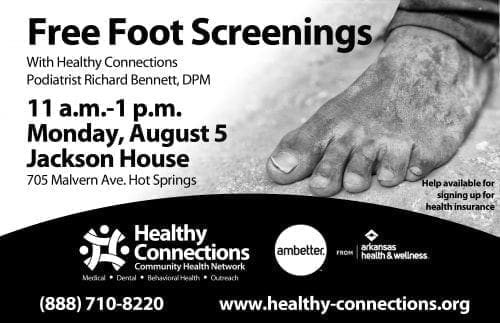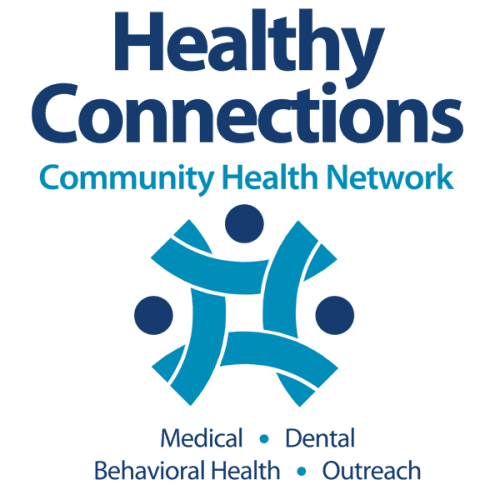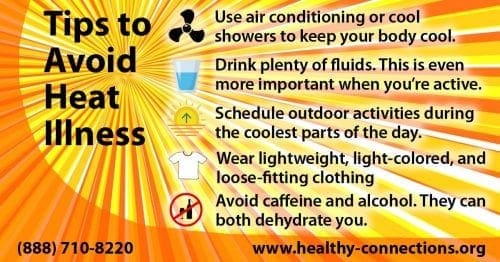 HOT SPRINGS — Healthy Connections will celebrate National Health Center Week by giving back to the community in Hot Springs.
HOT SPRINGS — Healthy Connections will celebrate National Health Center Week by giving back to the community in Hot Springs.
Healthy Connections Community Health Network, which operates two clinics in Hot Springs, will offer free podiatry foot screenings for those at the Eleanor Klugh Jackson House (705 Malvern Ave., Hot Springs) from 11 a.m. to 1 p.m. on Monday, Aug. 5. The event is made possible by Healthy Connections and Ambetter of Arkansas. Lunch will be provided.
Healthy Connections Podiatrist Richard Bennett, DPM, will perform the screenings in observance of the homeless population’s frequent issues with diabetes and disorders of the feet.
Healthy Connections is a Mena-based nonprofit Community Health Network serving the needs of children and adults throughout West-Central Arkansas. Since its founding in 1998 as a home-visiting program, Healthy Connections has been able to provide much-needed health, dental and social services to families of every lifestyle.
Bennett, who recently moved to Arkansas after more than 25 years of successful practice in downtown Chicago, specializes in disorders of the feet. He performs comprehensive diabetic foot exams and educates patients on how best to manage their condition. He diagnoses and treats basic foot conditions such as heel and arch pain, manages orthopedic deformities surgically and conservatively, performs office surgery for ingrown nails, abscesses, warts, and other skin lesions.
Community Health Centers serve 28 million patients across the United States, a number that continues to grow along with the demand for affordable health care. These centers reach beyond the walls of conventional medicine to address the social determinants of health affecting special patient populations.
Healthy Connections offers same-day appointments, convenient before and after work appointments, and accepts all insurances, including Medicaid, ARKids 1st, and Medicare. Learn more at www.healthy-connections.org. Call (888) 710-8220 for an appointment.
 Healthy Connections is launching a new brand identity, including a new logo, new colors and a consistent font designed to draw more attention.
Healthy Connections is launching a new brand identity, including a new logo, new colors and a consistent font designed to draw more attention.
Healthy Connections is a Mena-based nonprofit organization serving the needs of children and adults throughout West-Central Arkansas. What started as a home visiting program in 1998 is now is a Community Health Center and Specialty organization. It contains primary care, dental, behavioral health and pediatrics, and specialties like Podiatry, Cardiology, Physical Therapy, Chiropractic and soon to be women’s health. It also continues to be a home visiting program.
Currently, there are 10 clinics located in Mena, Hot Springs, Malvern, Arkadelphia, Mount Ida, and De Queen.
Tying all of these things together, Healthy Connections sought to establish an identity that was modern and fresh and leaves no doubt about who Healthy Connections is and what it does in the community.
The new look is bold, modern, flexible and leaves no doubt about who Healthy Connections is. The colors feature the same darker blue previously used, and a new lighter shade designed to complement. Both blue shades come to represent trust, intelligence, freedom, progress, and technology.
There are four parts to the branding.
- Bold “Healthy Connections”
This tells people immediately who Healthy Connections is in a font that is readable, whether big or small.
- “Community Health Network”
Healthy Connections is a community health network of medical-related specialties and social services that work in the community.
- The “Community” Mark
The symbol represents people intertwined to form a community. It might also represent a bit of an abstract H. Or others may see something completely different. Paired with “Healthy Connections” and “Community Health Network”, the new mark will come to represent the community that is served.
- The services
Healthy Connections provides Medical (including specialties), Dental, Behavioral Health and Outreach Services to the community.
Over the next 12-18 months, Healthy Connections will begin to implement the new branding. This will be done over a period of time as new items are ordered or as items need to be replaced. This will help keep costs down as we implement the new design.
 What are heat-related illnesses?
What are heat-related illnesses?
Exposure to abnormal or prolonged amounts of heat and humidity without relief or adequate fluid intake can cause various types of heat-related illness. Children and teens adjust more slowly than adults do to changes in environmental heat. They also produce more heat with activity than adults and sweat less. Sweating is one of the ways the body cools itself. Children and teens often don’t think to rest when having fun and may not drink enough fluids when playing, exercising, or participating in sports.
Children and teens with chronic health problems, or those who take certain medicines, may be more susceptible to heat-related illnesses. Children and teens who are overweight or wear heavy clothing during exertion, such as marching band or football uniforms, are also more susceptible.
Heat-related illness can occur in two ways, exertional and non-exertional. Exertional heat illness occurs when your child exerts themselves in a hot environment, such as practicing football on a hot day without any breaks. Non-exertional heatstroke occurs when a child is trapped in a hot environment. Examples of this would be an infant left in a car on a summer day or a child with disabilities left in a hot apartment without access to water.
Heat-related illness includes the following conditions based on the severity of a child’s condition:
-
Heat cramps
-
Heat exhaustion
-
Heatstroke
What are heat cramps?
Heat cramps are often the first sign that your body can’t handle the heat. These muscle cramps usually affect the legs arms, or abdomen. Heat cramps are the mildest form of heat illness and consist of painful muscle cramps and spasms that occur during or after intense exercise and sweating in high heat.
What is heat exhaustion?
Heat exhaustion can come on gradually (possibly over several days). Symptoms may include skin that is cool, most, and pail; dizziness; nausea; fainting; headache; and muscle cramps. People with heat exhaustion may also develop fast, shallow breathing and a rapid, weak pulse. Heat exhaustion is more severe than heat cramps and results from a loss of water and salt in the body. It occurs in conditions of extreme heat and excessive sweating without adequate fluid and salt replacement. Heat exhaustion occurs when the body is unable to cool itself properly and, if left untreated, can progress to heatstroke.
What is heatstroke?
Heatstroke is a Medical Emergency. Call 9-1-1. The body’s systems for cooling itself are shutting down, and body temperature can rise to 106 degrees. Look for: Red, hot, dry skin; rapid, strong pulse; throbbing headache; dizziness; nausea; confusion; and unconsciousness. Heatstroke, the most severe form of heat illness, occurs when the body’s heat-regulating system is overwhelmed by excessive heat. It is a life-threatening emergency and requires immediate medical attention.
 HOT SPRINGS — Healthy Connections will celebrate National Health Center Week by giving back to the community in Hot Springs.
HOT SPRINGS — Healthy Connections will celebrate National Health Center Week by giving back to the community in Hot Springs.



 Healthy Connections is launching a new brand identity, including a new logo, new colors and a consistent font designed to draw more attention.
Healthy Connections is launching a new brand identity, including a new logo, new colors and a consistent font designed to draw more attention. What are heat-related illnesses?
What are heat-related illnesses?